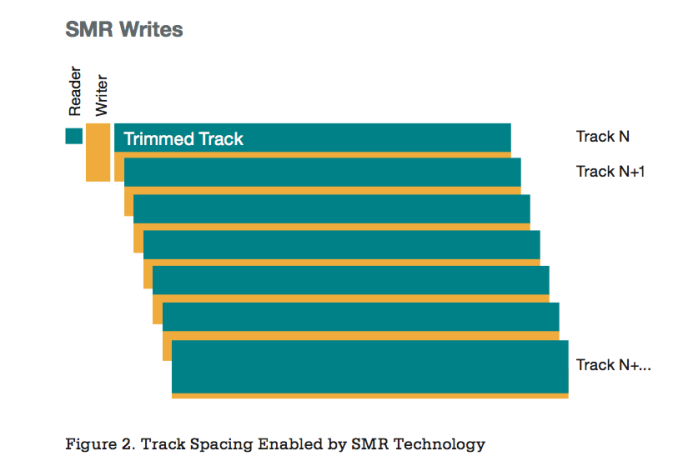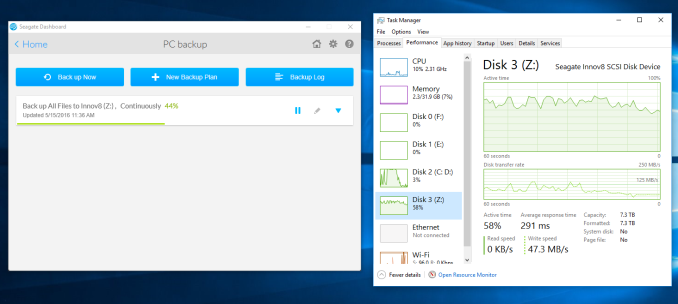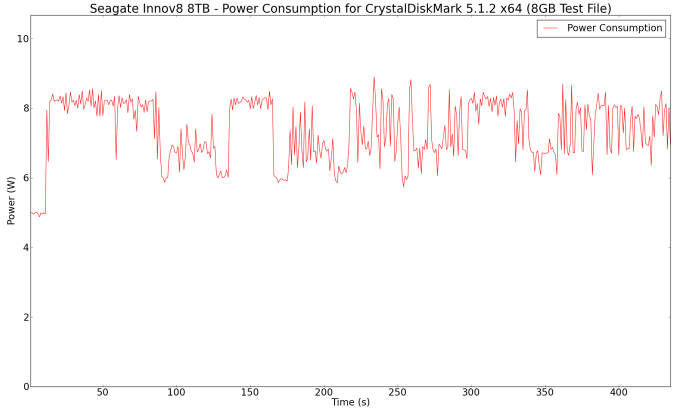Seagate Innov8 8TB Bus-Powered External Hard Drive Review
by Ganesh T S on May 19, 2016 8:30 AM ESTPerformance Consistency, Power and Thermal Characteristics
Shingled Magnetic Recording (SMR) presents a number of challenges when it comes to performance consistency. HDDs featuring shingled recording write new magnetic tracks that overlap part of the previously written tracks. By definition, this slows down write performance since the architecture requires HDDs to rewrite adjacent tracks after any writing operation. The Archive HDD uses drive-managed SMR, and this means that the firmware has been tweaked to ensure optimal performance using caching in the DRAM and even media caches.
In order to show the effect of the firmware on the performance of a SMR drive, let us first take a look at our performance consistency test for the Seagate Archive HDD CTU (clinical trial unit) that Segate provided us last year. That sample had firmware version AR13. As a reminder, our performance consistency test takes the robocopy benchmark described in the previous section and instruments it to record the drive temperature as well as instantaneous transfer rates during the process.
The Archive HDD in the Seagate Innov8 has firmware RT17 and is also behind a USB 3.1 Gen 1 - SATA bridge (unlike the direct SATA connection for the CTU numbers presented above). The performance consistency graph for the Seagate Innov8 is presented below.
Note that some of the issues still remain (such as writes slowing down after a lot of data has been dumped into the drive within a short time span and reads of recently written data being slow). However, they have been mitigated to a large extent. Users with average workloads are unlikely to frequently encounter issues similar to what we saw above, though it is not outside the realms of possibility as shown in the backup process screenshots below. We did confirm that this was not due to varying file sizes, but, do reflect our observations from the robocopy tests in the previous section.
Backups start off around 100 MBps, but slow down to around 50 MBps mid-way
Despite the lack of ventilation for the drive, the contact of the HDD with the metal shield and the aluminum chassis, combined with the low-power nature of the Archive HDD, ensure that the drive keeps reasonable temperatures even in our stress test. The maximum temperature we observed was only 45 C.
Evaluation of the power consumption of the Seagate Innov8 was done using Plugable's USBC-TKEY. Our test procedure and setup are outlined here. We track the power consumed by the drive during the course of the CrystalDiskMark benchmark.
Analyzing the power numbers for the Innov8 is tricky, as the power consumption is monitored at the USB interface. In order to get an additional data point, we also performed the power consumption measurement when processing the AnandTech DAS suite. It includes the PCMark 8 storage bench which involves drive conditioning.
These results show that the drive is subject to much more stress with the DAS suite, with power numbers often spiking upwards of 10W. At idle, the drive can go down to 5W, but, even then, we see spikes up to 6W which might be indicative of housekeeping duties associated with SMR management.
The graphs above also include the power consumed to charge the internal battery. Our experiments show that the Innov8 can take full advantage of ports that can deliver more than 7.5W of power to juice up the internal battery faster. The presence of the battery also ensures that any sudden spike in power requirements can be handled as long as the USB port can deliver 7.5W.

















41 Comments
View All Comments
Michael Bay - Friday, May 20, 2016 - link
Any projections when external hard drives will hit 16Tb? I`m using Seagate`s 8Tb now, and animoo fills it up rather fast.JimmiG - Friday, May 20, 2016 - link
Probably going to take a long time. In order to hit 8 - 10 TB, "hacks" like SMR or helium-filled drives were necessary. The write heads just can't get any smaller now. HAMR might unlock 16+ TB drives, if they ever manage to get it to the market at a reasonable cost.Michael Bay - Friday, May 20, 2016 - link
Okay, so another 8Tb external for me, then.coder111 - Friday, May 20, 2016 - link
Ok, so what about CPU usage?Drives connected via SATA have DMA, so they can bypass CPU for data copy and leave CPU free to do other stuff.
As far as I know, USB is incapable of doing DMA (security considerations is one reason for it, look up DMA attack). So any USB storage should have considerably higher CPU usage under heavy IO compared to SATA or SAS or ATA storage.
phoenix_rizzen - Friday, May 20, 2016 - link
I forget the name of it, but there's a USB storage mode specifically for this, that basically lets you stream data to the drive without sending each block through the CPU first. Supported in Windows 8 and above by default, I believe, with special drivers needed for Windows 7. Not sure about non-Windows support.Anandtech did a review of one of the earlier USB thumb drives that supported this showing the results of using bulk transfers over normal USB transfers. And I believe the newer external drives use something similar (SCSI-over-USB or something like that) to the same effect.
lagittaja - Saturday, May 21, 2016 - link
Well there's the "turbo mode" that increases the max transaction size for bulk-only transfer from 64K up to 2MB.And then there's UASP (or UAS) which is USB Attached SCSI.
extide - Monday, May 23, 2016 - link
Yeah there are those modes but they are still not DMA. USB does not do DMA. You can with Thunderbolt, though.extide - Monday, May 23, 2016 - link
Wow, seriously only 16MB of cache on this thing? Hopefully crystaldiskinfo is wrong here. I would think that for an SMR drive you would need lots of cache to make the performance decent. I wonder if maybe it has additional DRAM for smoothing out the writes a bit. You know some NAND would be great with one of these, have them do like 32-64GB of NAND plus an SMR drive, that could be pretty potent really. DOO ITTThumanentity - Tuesday, June 7, 2016 - link
Smr is trash.Mikuni - Sunday, June 12, 2016 - link
"$230" drive = $300 in Europe.